SpaceX CRS-25 Mission
EO
Land
Operational (nominal)
Hyperspectral imagers
Quick facts
Overview
| Mission type | EO |
| Agency | NASA-JPL |
| Mission status | Operational (nominal) |
| Launch date | 14 Jul 2022 |
| Measurement domain | Land |
| Measurement detailed | Mineral Type |
| Instruments | EMIT |
| Instrument type | Hyperspectral imagers |
| CEOS EO Handbook | See SpaceX CRS-25 Mission summary |
SpaceX CRS-25 mission to the ISS
CRS-25 is the 25th commercial resupply services mission of SpaceX, responsible for taking NASA's next climate change investigation to the International Space Station (ISS). Designed to analyse airborne dust, the Earth Surface Mineral Dust Source Investigation (EMIT) mission launched on Thursday, 14 July 2022, alongside other science payloads.1)
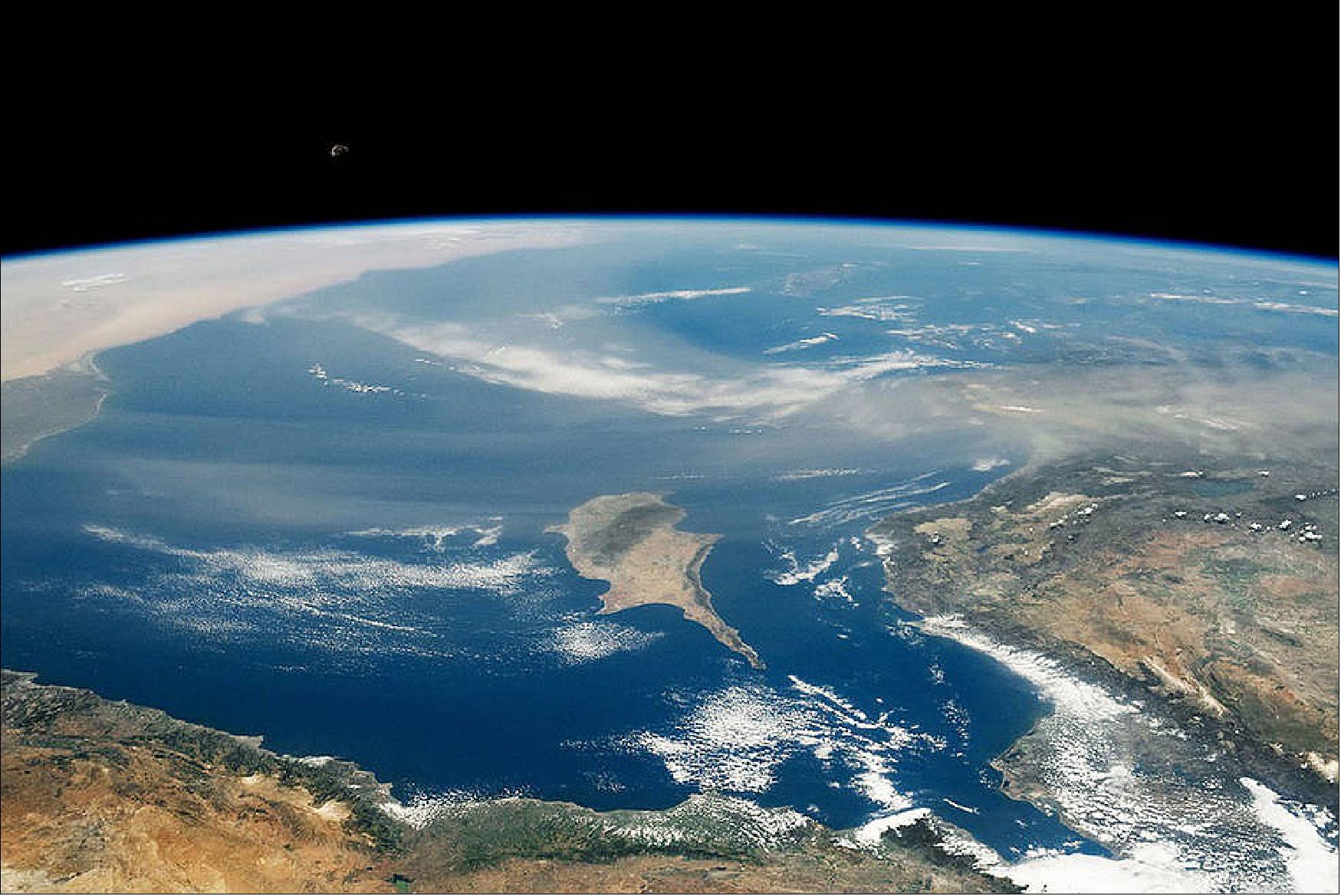
Each year, strong winds carry more than a billion metric tons – or the weight of 10,000 aircraft carriers – of mineral dust from Earth’s deserts and other dry regions through the atmosphere. While scientists know that the dust affects the environment and climate, they do not have enough data to determine, in detail, what those effects are or may be in the future – at least not yet.
Set to launch to the International Space Station aboard a SpaceX Dragon spacecraft on Thursday, July 14, at 8:44 p.m. EDT (5:44 p.m. PDT), NASA’s Earth Surface Mineral Dust Source Investigation (EMIT) instrument will help fill in those knowledge gaps. EMIT’s state-of-the-art imaging spectrometer, developed by the agency’s Jet Propulsion Laboratory in Southern California, will collect more than a billion dust-source-composition measurements around the globe over the course of a year – and in doing so, significantly advance scientists’ understanding of dust’s influence across the Earth system.
Here are five things to know about EMIT:
1) It will identify the composition of mineral dust from Earth’s arid regions.
Desert regions produce most of the mineral dust that makes its way into the atmosphere. They’re also largely remote, making it difficult for scientists to collect soil and dust samples over these vast areas by hand.
From its perch on the space station, EMIT will map the world’s mineral dust source regions. The imaging spectrometer will also provide information on the color and composition of dust sources globally for the first time. This data will help scientists understand which kinds of dust dominate each region and advance their understanding of dust’s impact on climate and the Earth system today and in the future.
Figure 2: Using image spectrometer technology developed at JPL, NASA’s EMIT mission will map the surface composition of minerals in Earth’s dust-producing regions, helping climate scientists better understand the impact of airborne dust particles in heating and cooling the planet’s atmosphere (video credit: NASA/JPL-Caltech)
2) It will clarify whether mineral dust heats or cools the planet.
Right now, scientists do not know whether mineral dust has a cumulative heating or cooling effect on the planet. That is because dust particles in the atmosphere have different properties. For instance, some particles may be dark red, while others may be white.
The color matters because it determines whether the dust will absorb the Sun’s energy, as dark-colored minerals do, or reflect it, as light-colored minerals do. If more of the dust absorbs the Sun’s energy than reflects it, it’ll warm the planet, and vice versa.
EMIT will provide a detailed picture of how much dust comes from dark versus light minerals. That information will allow scientists to determine whether dust heats or cools the planet overall, as well as regionally and locally.
3) It will help scientists understand how dust affects different Earth processes.
Mineral dust particles vary in color because they’re made of different substances. Dark red mineral dust gets its color from iron, for example. The composition of dust particles affects how they interact with many of Earth’s natural processes.
For instance, mineral dust plays a role in cloud formation and atmospheric chemistry. When mineral dust is deposited in the ocean or forests, it can provide nutrients for growth, acting like fertilizer. When it falls on snow or ice, the dust accelerates melting, leading to more water runoff. And for humans, mineral dust can be a health hazard when inhaled.
EMIT will collect information on 10 important dust varieties, including those that contain iron oxides, clays, and carbonates. With this data, scientists will be able to assess precisely what effects mineral dust has on different ecosystems and processes.
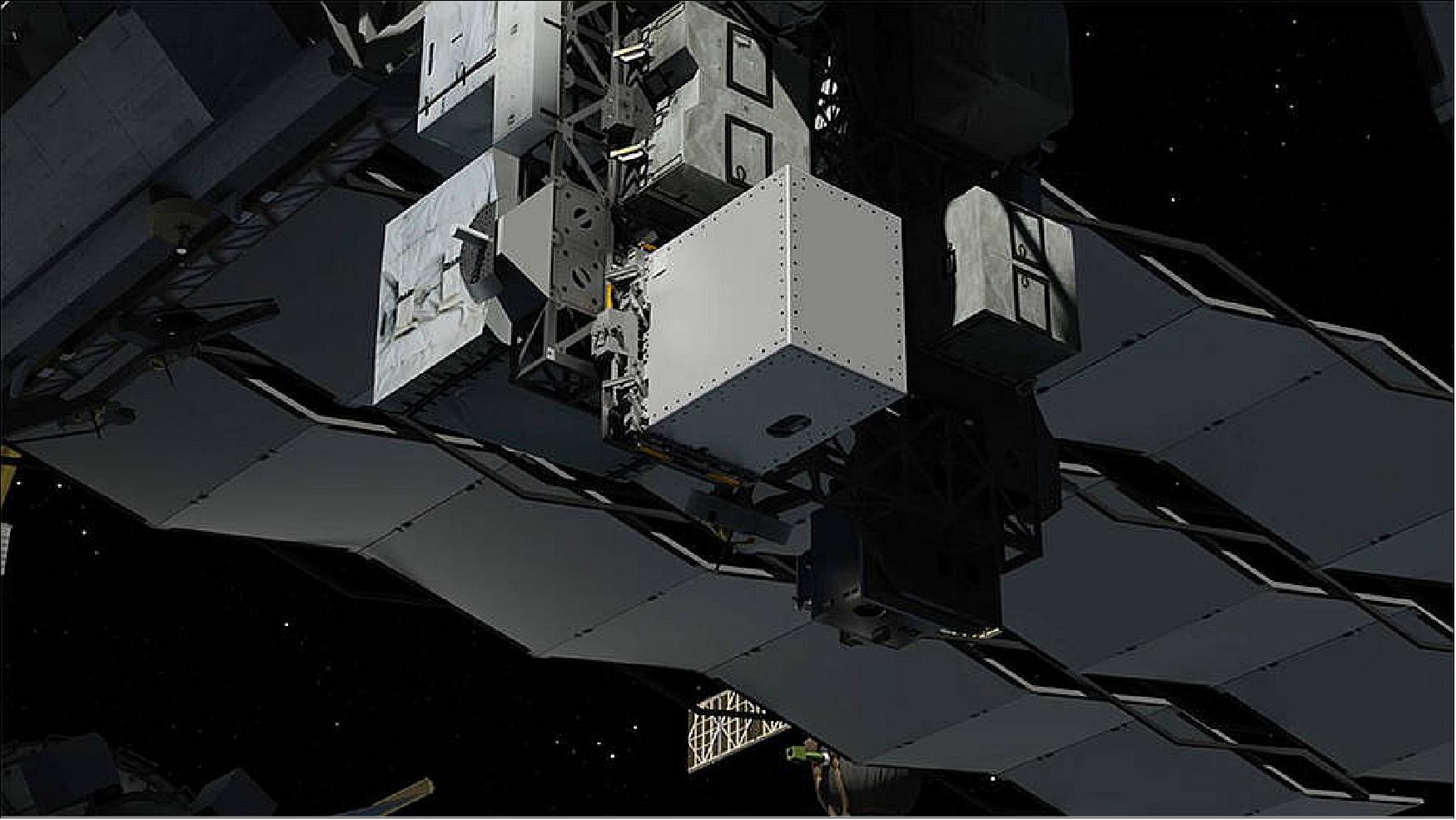
Figure 3: As depicted in this illustration, NASA’s EMIT will be attached to Express Logistics Carrier 1, a platform on the International Space Station that supports external science instruments. The mission will help scientists better understand the role of airborne dust in heating and cooling the atmosphere (image credit: NASA/JPL-Caltech)
4) Its data will improve the accuracy of climate models.
In the absence of more specific data, scientists currently characterize mineral dust in climate models as yellow – a general average of dark and light. Because of this, the effects that mineral dust may have on climate – and that climate may have on mineral dust – are not well represented in computer models.
Color and composition information gathered by EMIT will change that. When the instrument’s data is incorporated, the accuracy of climate models is expected to improve.
5) It will help scientists predict how future climate scenarios will affect the type and amount of dust in our atmosphere.
As global temperatures rise, arid regions may become even drier, possibly resulting in larger (and dustier) deserts. To what extent this might happen depends on several factors, including how much temperatures rise, how land use changes, and how rainfall trends change.
By incorporating EMIT’s global dust source composition data into models and predictions, scientists will gain a better understanding of how the amount and composition of dust in arid regions may change under different climate and land-use scenarios. They’ll also gain a better understanding of how these changes may impact climate in the future.
More about the mission: EMIT was developed at NASA’s Jet Propulsion Laboratory, which is managed for the agency by Caltech in Pasadena, California. It will launch from Kennedy Space Center in Florida to the International Space Station aboard SpaceX’s 25th commercial resupply services mission for NASA. Once EMIT begins operation, its data will be delivered to the NASA Land Processes Distributed Active Archive Center (DAAC) for use by other researchers and the public.
Launch
A SpaceX cargo Dragon spacecraft is on its way to the International Space Station after a July 14 launch delayed more than a month by a hydrazine leak on the spacecraft. — A Falcon 9 lifted off from Kennedy Space Center’s Launch Complex 39A at 8:44 p.m. EDT on 14 July 2022 (00:44 UTC on 15 July), deploying the Dragon into low Earth orbit 12 minutes later. The spacecraft is scheduled to dock with the station at about 11:20 a.m. EDT July 16. 2) 3) 4)
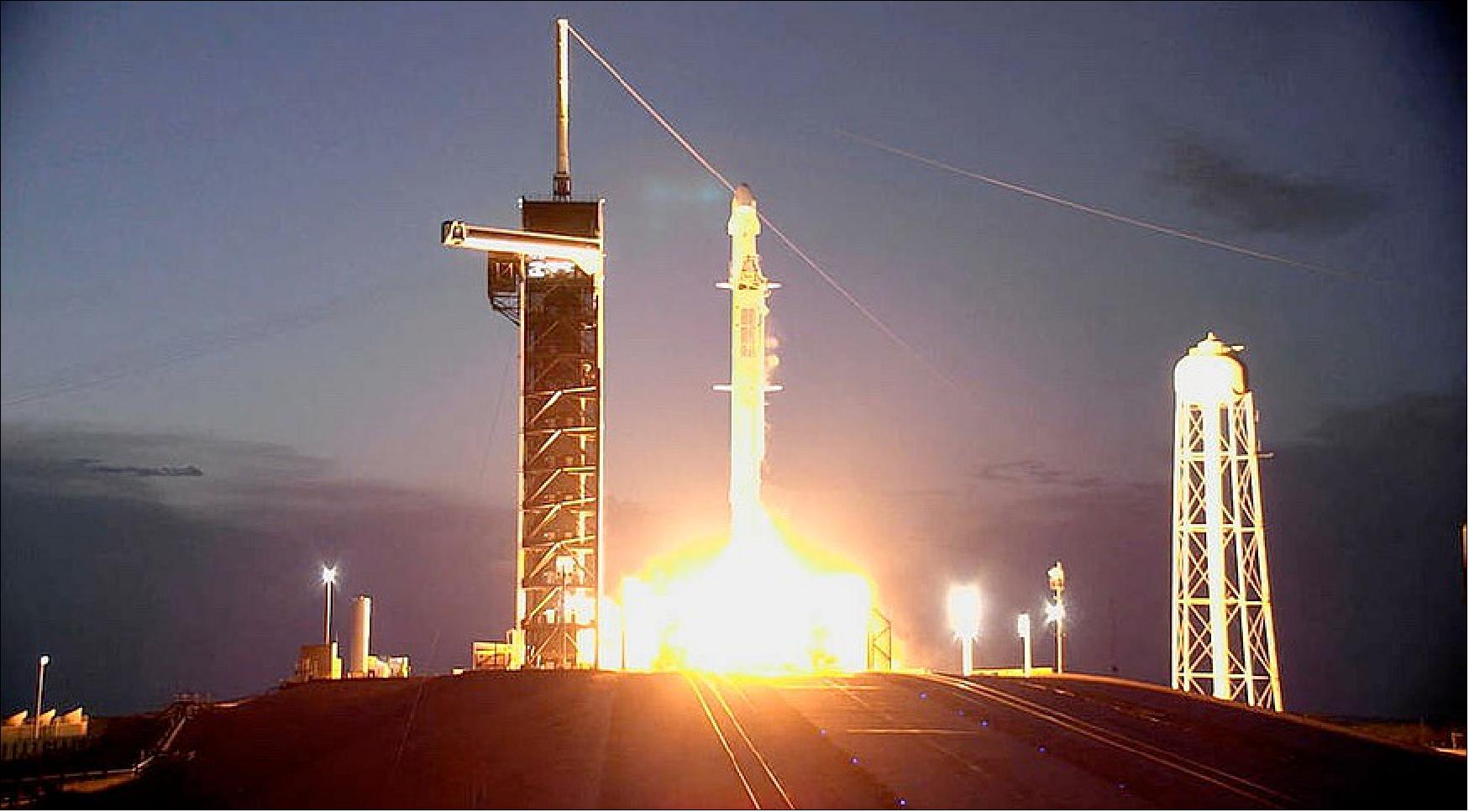
The Falcon 9 first stage landed on a droneship in the Atlantic Ocean seven and a half minutes after liftoff. The stage completed its fifth flight, having previously launched the Crew-3, Crew-4 and CRS-22 missions for NASA and the Turksat 5B communications satellite. The launch was the 30th so far this year for SpaceX, versus 31 for all of 2021.
The Dragon spacecraft, flying a mission designated CRS-25, is carrying 2,668 kg of cargo, including science investigations as well as crew supplies, spacewalk equipment and hardware. That total includes 544 kg of equipment located in the unpressurized trunk section of the spacecraft.
Among the science payloads is an Earth science instrument called the Earth Surface Mineral Dust Source Investigation (EMIT), that will be installed on the station’s exterior. It will be used to study dust mineral dust in the atmosphere and how it interacts with ecosystems globally.
“We really need to be able to model how dust interacts with the full Earth system,” said Robert Green, principal investigator for EMIT at the Jet Propulsion Laboratory, during a NASA briefing in June. EMIT will provide far more data on mineral dust than other sensors. “We will use these new measurements to update those Earth system models and bring better fidelity to the Earth system models.” The instrument will also support planning for the Earth System Observatory line of future missions.
The CRS-25 mission had been scheduled to launch in early June. However, NASA and SpaceX postponed the launch after detecting what NASA called “elevated vapor readings” of hydrazine in the spacecraft’s propulsion system. Dragon uses monomethyl hydrazine and nitrogen tetroxide as propellants for its Draco thrusters that handle its approach to and departure from the ISS, and deorbiting at the end of the mission.
At a prelaunch briefing July 13, Benji Reed, senior director of human spaceflight programs at SpaceX, said the company traced the leak to imperfections in a “sealing surface” where a valve connects into the propulsion system. “We replaced that valve and then we thoroughly tested the system to confirm that there is no further leakage,” he said.
He added the problem was not with the valve itself but with the sealing of joints and unions in the plumbing. The sealing surface around the valve had been “reworked” but appeared fine, he said. Initial tests of the propulsion system during assembly did not detect a leak, but may not have been sufficient to detect that leak if it existed at that time. SpaceX found the leak only in “full up” system testing ahead of launch.
“Since then we have made updates to our processes,” Reed said. One involves how to do rework on sealing surfaces for “stricter acceptability.” The company is also incorporating more rigorous testing processes.
The issue is isolated to the Dragon spacecraft flying this mission. “We did look very closely at that,” he said, but did not find similar problems on other Dragon spacecraft in the fleet. There is also no sign of any leak on the Crew Dragon spacecraft currently docked to the station on the Crew-4 mission.
During the investigation of this leak, SpaceX decided to replace the parachutes on the spacecraft. Reed said that was done as a precaution because hydrazine vapors could have degraded the parachutes. “The initial results from those inspections are coming in and those original parachutes look great,” he said. “We’ll likely use those on a future mission if the teams determine they’re safe to use for flight.”
Dana Weigel, NASA ISS deputy program manager, said at the prelaunch briefing that NASA plans to keep Dragon at the station for 33 days before undocking and splashing down off the Florida coast. The spacecraft will bring back about 50 science investigations as well as space station hardware that is being repaired or replaced.
That includes a spacesuit that suffered a small water leak during a March spacewalk, or EVA, by European Space Agency astronaut Matthias Maurer, causing water to pool on his helmet visor. NASA has since suspended spacewalks at the station except for contingencies.
Weigel said NASA is eager to get the suit back so engineers can determine the cause of the leak. “That’s really key for us,” she said. “That will be part of what we need for our assessment” to allow spacewalks to resume.
After CRS-25, the next commercial cargo mission is NG-18, a Northrop Grumman Cygnus mission tentatively scheduled for mid-October. The SpaceX CRS-26 Dragon mission will follow late in the year, delivering among other cargo a set of solar arrays to be installed on the station by spacewalking astronauts. “That’s our next target for when we’re hoping to be able to do a planned EVA,” Weigel said.
CRS-25 Research Payloads
Here are more details on some of the research launching to the space station: 5)
Mapping Earth’s dust
The Earth Surface Mineral Dust Source Investigation (EMIT), developed by NASA’s Jet Propulsion Laboratory in California, employs NASA imaging spectroscopy technology to measure the mineral composition of dust in Earth's arid regions. Mineral dust blown into the air can travel significant distances and have impact Earth’s climate, weather, vegetation, and more. For example, dust containing dark minerals that absorb sunlight can warm an area, while light-colored mineral dust can cool it. Blowing dust also affects air quality, surface conditions such as rate of snow melt, and phytoplankton health in the ocean. The investigation collects images for one year to generate maps of the mineral composition in the regions on Earth that produce dust. Such mapping could advance our understanding of the effects of mineral dust on human populations now and in the future. — See also the file ISS-EMIT on the eoPortal for further information.
Speedier immune system aging
Aging is associated with changes in the immune response known as immunosenescence. Microgravity causes changes in human immune cells that resemble this condition but happen faster than the actual process of aging on Earth. The Immunosenescence investigation, sponsored by ISS National Lab, uses tissue chips to study how microgravity affects immune function during flight and whether immune cells recover post-flight. Tissue chips are small devices that contain human cells in a 3D structure, allowing scientists to test how those cells respond to stresses, drugs, and genetic changes.
"Immune aging impacts tissue stem cells and their ability to repair tissues and organs,” says principal investigator Sonja Schrepfer, professor of surgery at University of California San Francisco. “Our studies aim to understand critical pathways to prevent and to reverse aging of immune cells.”
"Spaceflight conditions enable the study of immune aging that would not be feasible in the lab,” says co-investigator Tobias Deuse, professor of surgery at UCSF. This work could support development of treatments for immune system aging on Earth. The investigation also could support development of methods to protect astronauts during future long-duration spaceflight.
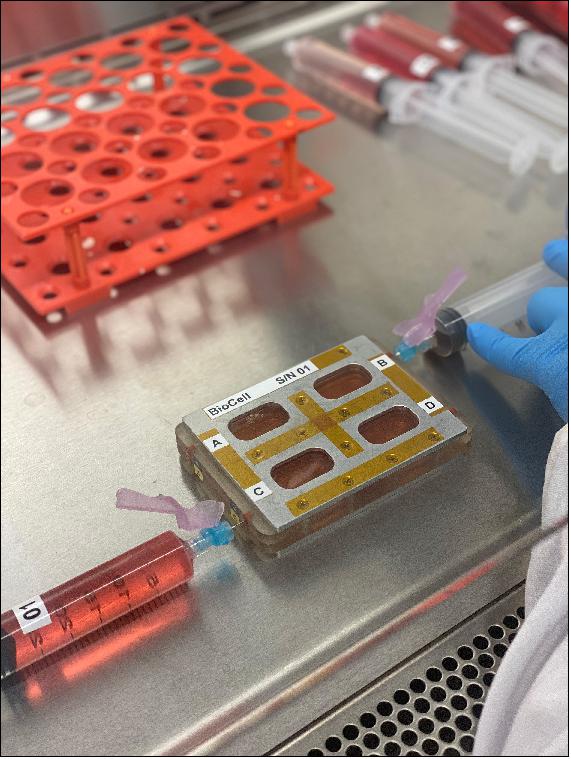
Figure 5: Pre-flight preparation of tissue chips for the Immunosenescence investigation, which studies the effects of microgravity on immune function to determine the mechanisms behind immune system aging (image credits: Sonja Schrepfer, University of California San Francisco)
Small satellites, big science
One of five CubeSats on this mission sponsored by NASA’s Launch Services Program, BeaverCube launches to the space station for deployment into low-Earth orbit. The small satellite uses multiple cameras, one that takes color images of Earth’s oceans and two that collect thermal images of cloud tops and the ocean surface. Cloud top and ocean surface temperatures help scientists understand Earth’s climate and weather systems. The collected data also can improve understanding of the ocean’s concentration of phytoplankton, a significant factor in the generation of atmospheric oxygen.
"Most Earth observation missions primarily image over land, focusing on populated areas and targets of interest. BeaverCube will focus on imaging oceans and coastal regions, combining thermal images with visible images to help us better understand ocean fronts,” says principal investigator Kerri Cahoy, professor of aeronautics and astronautics at the Massachusetts Institute of Technology. “BeaverCube also plans to demonstrate electrospray propulsion, to understand its performance before and after drag forces begin to significantly affect the spacecraft and we deorbit."
Soil in space
On Earth, complex communities of microorganisms carry out key functions in soil, including cycling of carbon and other nutrients and supporting plant growth. DynaMoS, sponsored by NASA’s Division of Biological and Physical Sciences (BPS), examines how microgravity affects metabolic interactions in communities of soil microbes. This research focuses on microbe communities that decompose chitin, a natural carbon polymer on Earth.
“Soil microorganisms carry out beneficial functions that are essential for life on our planet,” says principal investigator Janet K. Jansson, chief scientist and laboratory fellow at Pacific Northwest National Laboratory. “To harness these beneficial activities for future space missions, we need to understand more about how conditions in space, like microgravity and radiation, influence these microbes and the beneficial functions that they provide. Perhaps in the future, we will use beneficial soil microbes to enhance growth of crops on the lunar surface.”
Improved understanding of the function of soil microorganism communities also could reveal ways to optimize these communities to support agricultural production on Earth.
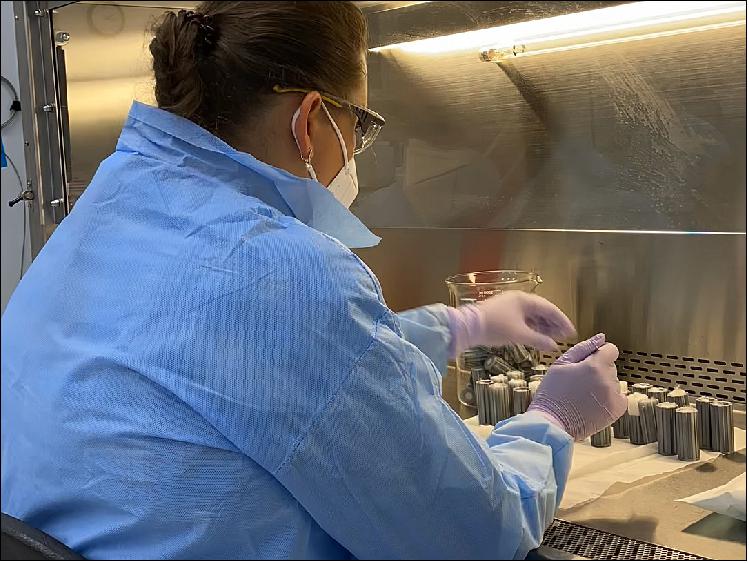
Figure 6: Preparation of sample tubes for DynaMoS, which examines how microgravity affects metabolic interactions in communities of soil microbes. Each tube contains chitin and sterile soil inoculated with a community of microbes (image credit: Pacific Northwest National Laboratory)
Genes, no cells
Cell-free technology is a platform for producing protein without specialized equipment of living cells that need to be cultured. Genes in Space-9, sponsored by the ISS National Lab, demonstrates cell-free production of protein in microgravity and evaluates two cell-free biosensors that can detect specific target molecules. This technology could provide a simple, portable, and low-cost tool for medical diagnostics, on-demand production of medicine and vaccines, and environmental monitoring on future space missions.
“Biosensors are a class of synthetic biology tools with immense potential for spaceflight applications in contaminant detection, environmental monitoring, and point-of-care diagnostics,” said Selin Kocalar, student winner of Genes in Space 2021. “This investigation seeks to validate their use aboard the space station. If it is successful, Genes in Space-9 will lay the foundation for downstream applications of biosensors for space exploration and resource-limited settings on Earth."
Genes in Space, an annual research competition, challenges students in grades 7 through 12 to design DNA experiments to be conducted on the space station. The program has launched eight investigations so far, and some have resulted in publications furthering our knowledge on genetics experiments through space-based research, including the first experiment to use CRISPR technology in microgravity in 2019.
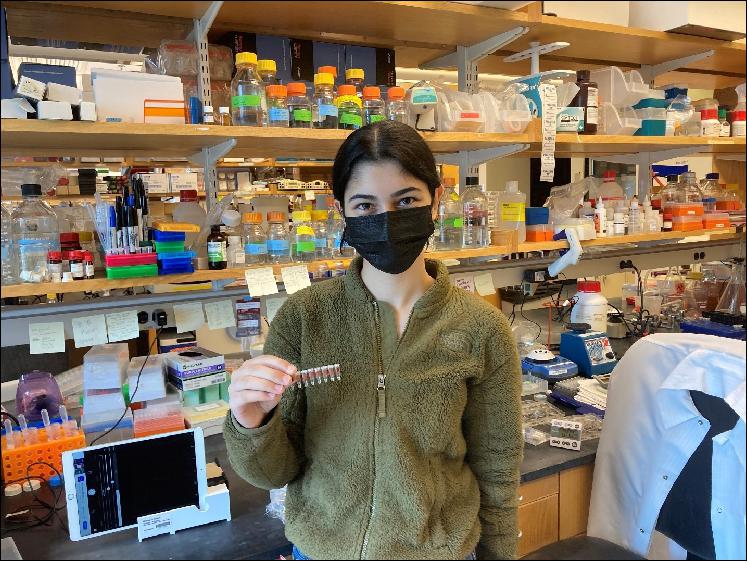
Figure 7: Selin Kocalar, the student who designed the experiment on which Genes in Space-9 is based, prepares her samples for launch (image credit: Genes in Space)
Better concrete
Biopolymer Research for In-Situ Capabilities looks at how microgravity affects the process of creating a concrete alternative made with an organic material and on-site materials such as lunar or Martian dust, known as a biopolymer soil composite (BPC). Using resources available where construction takes place makes it possible to increase the mass of the construction material and, therefore, the amount of shielding.
"Astronauts on the Moon and Mars will need habitats that provide radiation shielding, but transporting large amounts of conventional construction materials from Earth is logistically and financially infeasible,” said team member Laywood Fayne. “Our student team, led by Michael Lepech from the Blume Earthquake Engineering Center at Stanford University, is studying a way to convert regolith in these environments into a concrete-like material by mixing in water and a protein known as bovine serum albumin.”
This material hardens as the water evaporates, a process affected by gravity, explains team co-lead James Wall. “Our project consists of making six bricks in microgravity to compare to bricks made on Earth at 1 g and less than 1 g,” Wall says. “We will investigate the number and orientations of protein bridges, compressive strength, and porosity. Our conclusions could help determine how these bricks might form on the Moon and Mars.”
BPCs also could offer an environmentally friendly concrete alternative for making structures on Earth. In 2018, concrete production represented 8% of global carbon emissions. BPC material has zero carbon emissions and can be made from local, readily available resources, which also simplifies supply chains. This experiment is a part of NASA’s Student Payload Opportunity with Citizen Science (SPOCS) program, which provides students enrolled in institutions of higher learning the opportunity to design and build an experiment to fly to and return from the International Space Station.
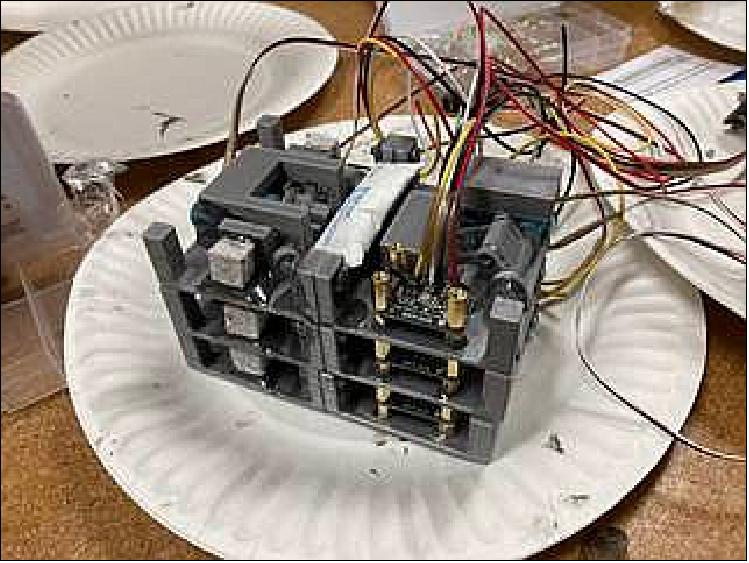
Figure 8: Flight hardware for the Biopolymer Research for In-Situ Capabilities, an investigation of how microgravity affects the process of creating a concrete alternative made with an organic material and on-site materials such as lunar or Martian dust. Each module makes two bricks, for a total of six bricks made in space (image credit: James Wall)
ELaNa 45 Payloads
ELaNa is an initiative that was proposed by NASA and is managed by the Launch Services Program (LSP) at NASA’s Kennedy Space Center. The main aim of this program is to collaborate with universities all across the US to design, manufacture, and launch research satellites into space. ELaNa brings university students closer to real space missions, giving them opportunities to dive in and get involved in the process from A to Z, from designing and assembling CubeSats, to launching and operating them. ELaNa 45 consist of the following CubeSats:
• BeaverCube of MIT (Massachusetts Institute of Technology), Cambridge, Massachusetts
• CapSat-1, The Weiss School, Palm Beach Gardens, Florida
• CLICK A (CubeSat Laser Infrared Crosslink), NASA’s Ames Research Center, Mountain View, California
• D3 (Drag De-Orbit Device CubeSat), Embry-Riddle Aeronautical University (ERAU), Daytona Beach, Florida
• JAGSAT, University of South Alabama, Mobile, Alabama
In addition to the ELaNa CubeSats:
• TUMnanoSAT (Technical University of Moldova Nano-Satellite), a 1U CubeSat developed at the Technical University of Moldova (TUM), located in Chişinău, Moldova. The objective of TUMnanoSAT is to provide hands-on practical training to the students participating in the project. Scientific and research objectives include testing the CubeSat sensors, as well as the communication link for the CubeSat. With a small on-board camera, the CubeSat will aim to capture Earth images as a step forward for Moldova toward eventually developing its own Earth observation satellite. 6)
Mission Status
• July 27, 2022: This week's image shows ESA astronaut Samantha Cristoforetti hard at work on her first ever spacewalk, conducted alongside cosmonaut Oleg Artemyev. Not only that, but this spacewalk was also the first conducted by a European woman, and the first conducted by a European in an Orlan spacesuit from the International Space Station. Congratulations, Samantha! 7)
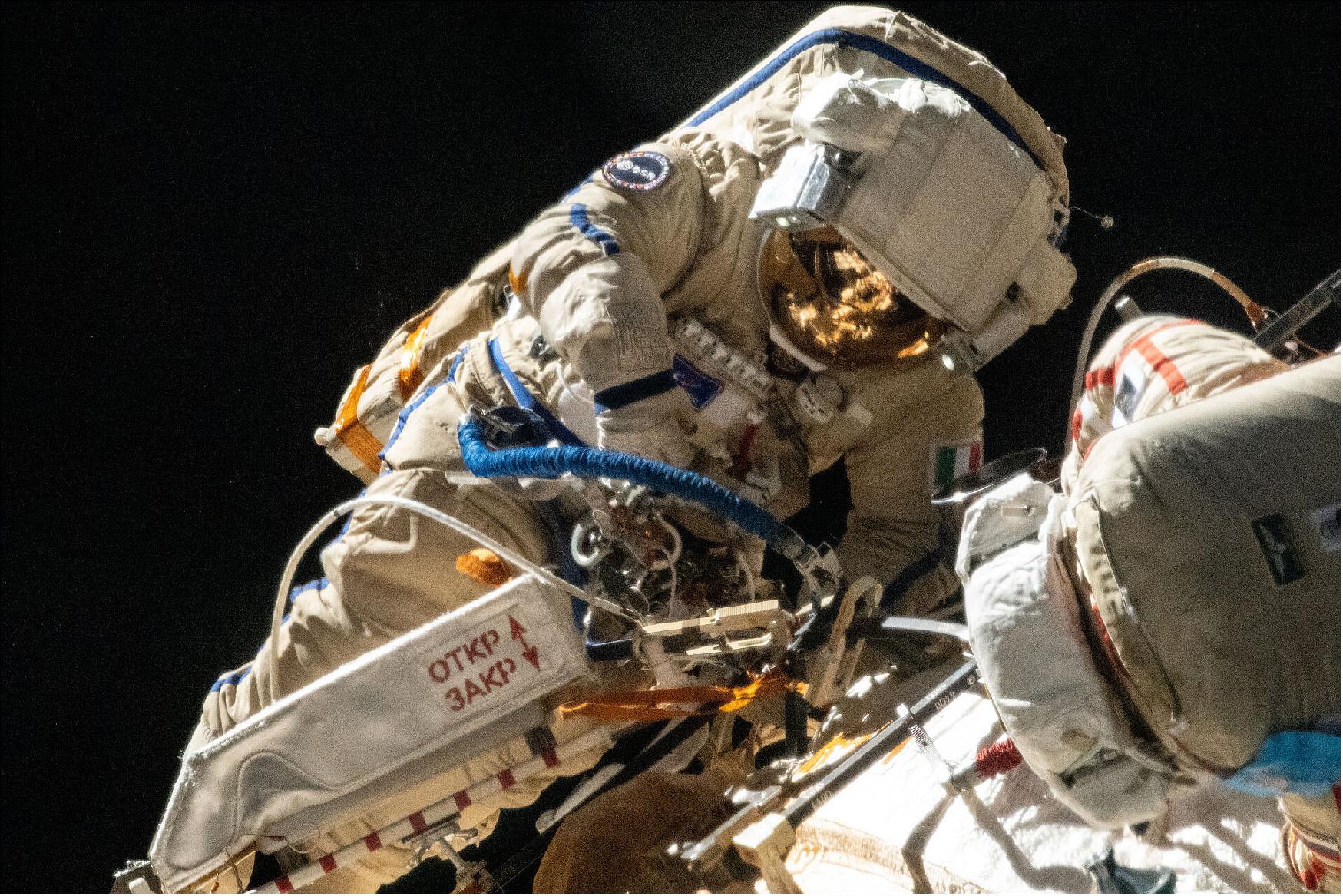
Figure 9: A spacewalk full of firsts (image credit: ESA/NASA)
- The pair of spacewalkers worked on a number of tasks over the course of their seven-hour Extravehicular Activity, also known as an EVA. After being assisted into their gear by cosmonaut Sergei Korsakov, Samantha and Oleg exited the Space Station via the airlock of the Poisk module, and proceeded to deploy ten nanosatellites by hand as part of a radio technology experiment.
- The European Robotic Arm (ERA) received a lot of attention during this spacewalk. In preparations for the ERA’s first operations on the newest Space Station’s laboratory module, Nauka, Samantha and Oleg installed a temporary ERA adapter, removed and replaced a protective window on the arm’s camera unit, as well as switched its control panel to stowage mode.
- The duo also installed platforms and workstation adapter hardware mounted on Nauka. Due to a slight delay, scheduled boom installation to aid movement in future EVAs has been deferred to a future spacewalk.
- After a job well done, both Samantha and Oleg took a well-deserved lie-in on 22 July. They did, however, spend the rest of the day hard at work cleaning and checking the various components of each of the Orlan spacesuits.
• July 21, 2022: Expedition 67 Commander Oleg Artemyev of Roscosmos and Flight Engineer Samantha Cristoforetti of ESA (European Space Agency) concluded their spacewalk at 5:55 p.m. EDT after 7 hours and 5 minutes. 8)
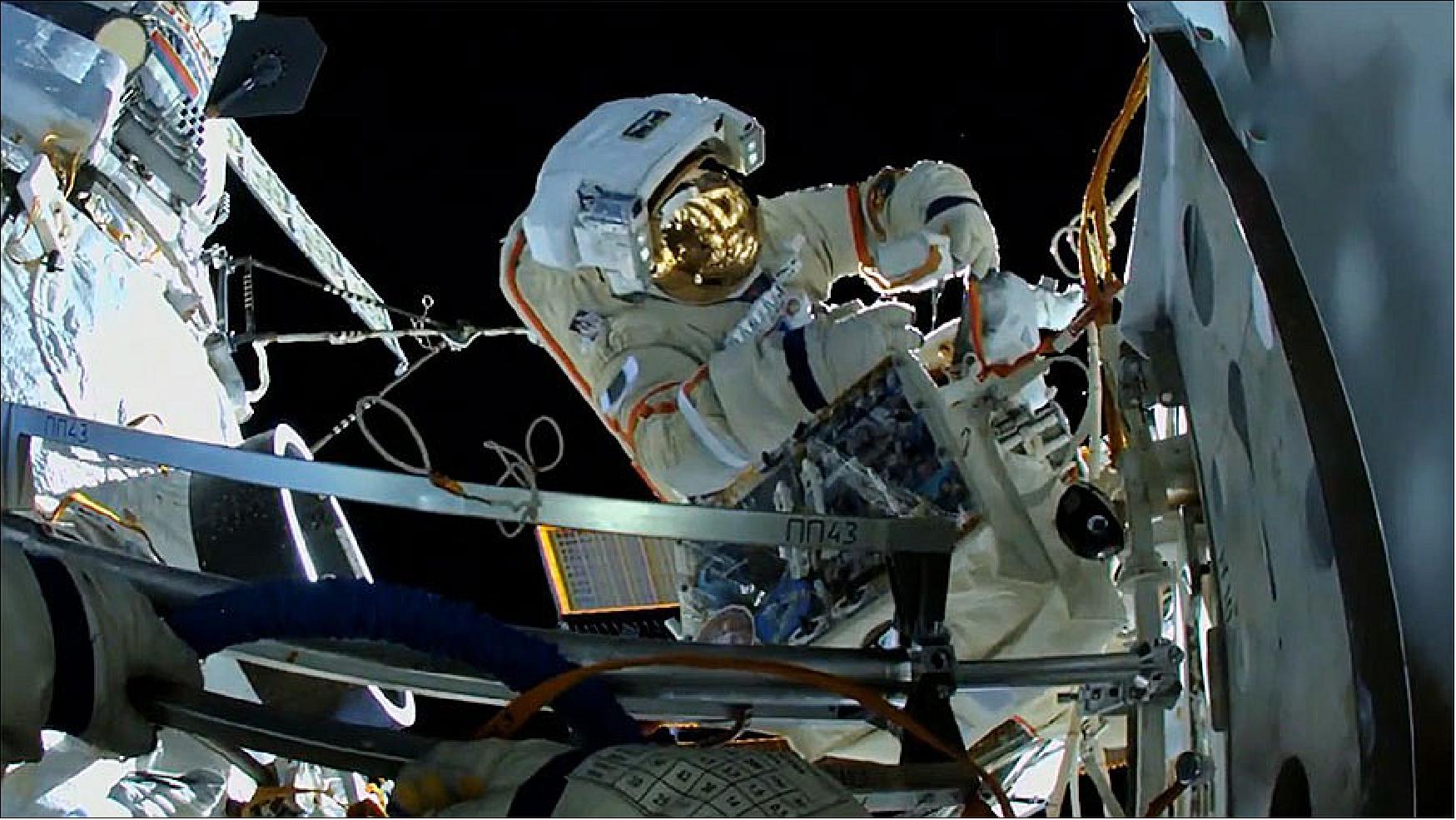
Figure 10: ESA astronaut Samantha Cristoforetti works outside the space station’s Russian segment to configure the new European robotic arm (image credit:NASA TV)
- Artemyev and Cristoforetti completed all but one of their major objectives, which included the deployment of 10 nanosatellites designed to collect radio electronics data during the spacewalk and installing platforms and workstation adapter hardware near the 37-foot-long manipulator system mounted to Nauka. The spacewalkers also relocated the arm’s external control panel and replaced a protective window on the arm’s camera unit. The last planned activity, to extend a Strela telescoping boom from Zarya to Poisk, will be completed on a future spacewalk.
- Additional spacewalks are planned to continue outfitting the European robotic arm and to activate Nauka’s airlock for future spacewalks.
- The work on the European robotic arm will be used to move spacewalkers and payloads around the Russian segment of the station.
- This was the sixth spacewalk in Artemyev’s career, and the first for Cristoforetti. It was the sixth spacewalk at the station in 2022 and the 251st spacewalk for space station assembly, maintenance, and upgrades.
• July 20, 2022: On 21 July 2022, ESA astronaut Samantha Cristoforetti will head outside the International Space Station on a spacewalk alongside cosmonaut Oleg Artemyev. It will be Samantha’s first spacewalk, and the first conducted by a European woman. 9)
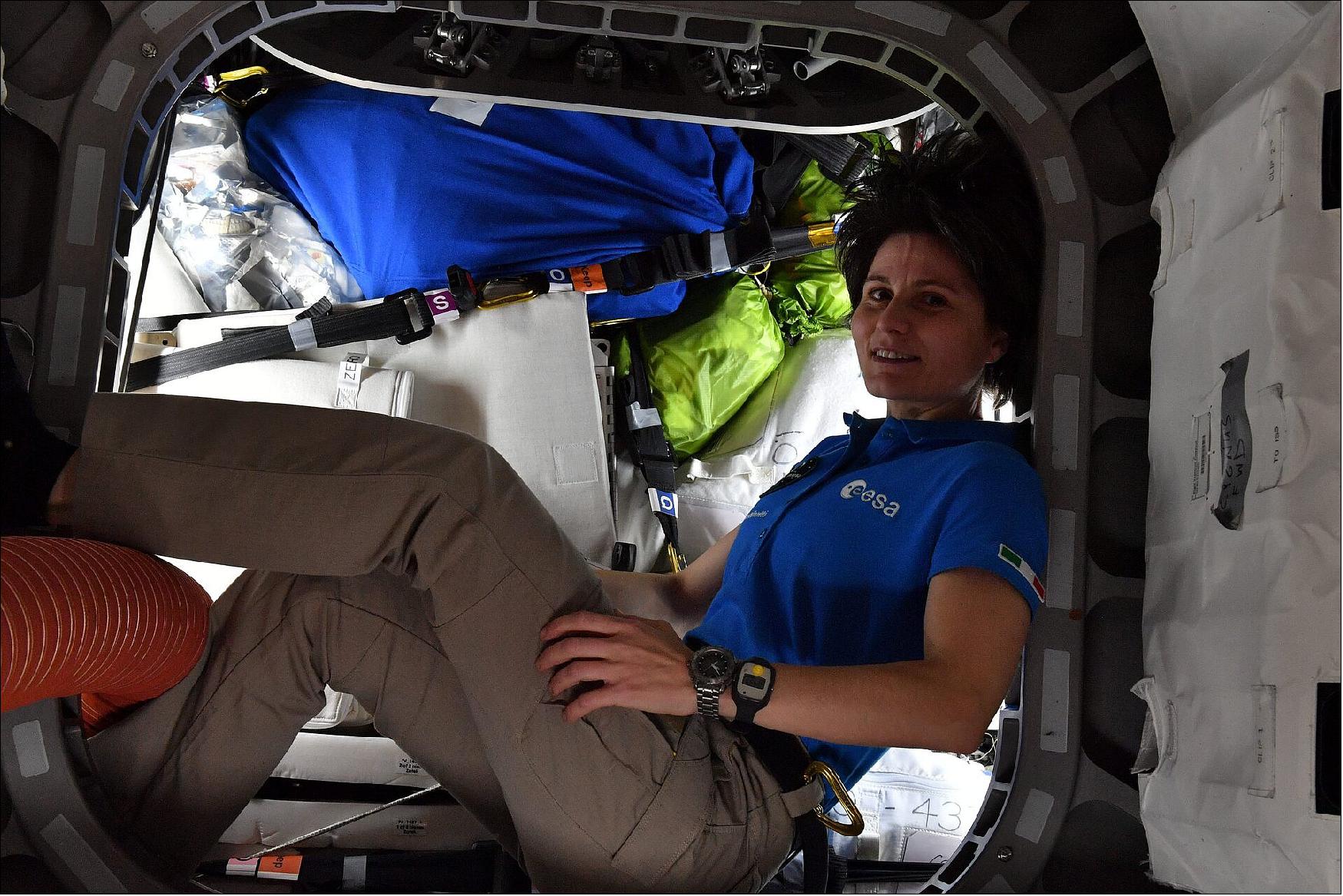
Figure 11: ESA astronaut Samantha Cristoforetti and her Expedition 67 crew mates say goodbye to the Northrop Grumman Cygnus spacecraft as it departs the International Space Station. Cygnus departed from the station on 13 July 2022 ((image credit: ESA/NASA)
- Both astronauts will be wearing Orlan spacesuits, with Oleg wearing red stripes and Samantha wearing blue stripes. Sergei Korsakov will provide support to the spacewalkers before they exit the Space Station through the space-facing Poisk module.
- The spacewalk, also called an Extravehicular Activity (EVA), will see Samantha and Oleg working together on a number of tasks, including installing platforms and workstation adapter hardware mounted on the Nauka laboratory module.
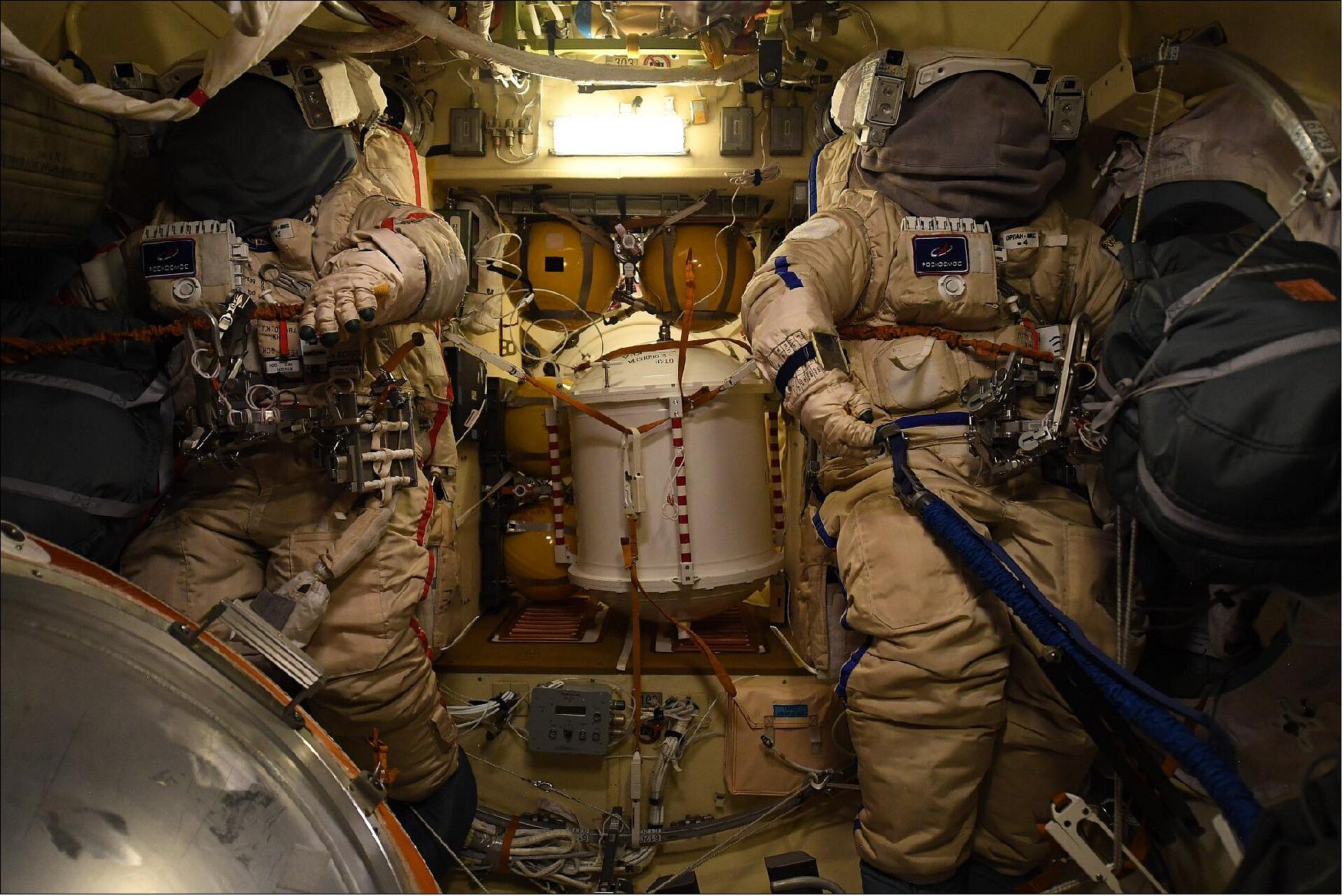
Figure 12: Russian Orlan spacesuits on the International Space Station (image credit: ESA/NASA)
- The spacewalking duo will deploy ten nanosatellites designed to collect radio electronics data during the EVA, and put in place a telescopic boom in place from Zarya to Poisk to assist in future spacewalks.
Working on European Robotic Arm
- This will be the third spacewalk to include tasks around getting the European Robotic Arm (ERA) ready for its first operations on Nauka. The astronauts will move its external control panel, work on insulation and install a temporary adapter point for the robotic arm.
- Samantha will spend some time making sure a window shield on the arm’s camera unit is clear enough to allow a laser light to guide the arm for grappling and moving around.
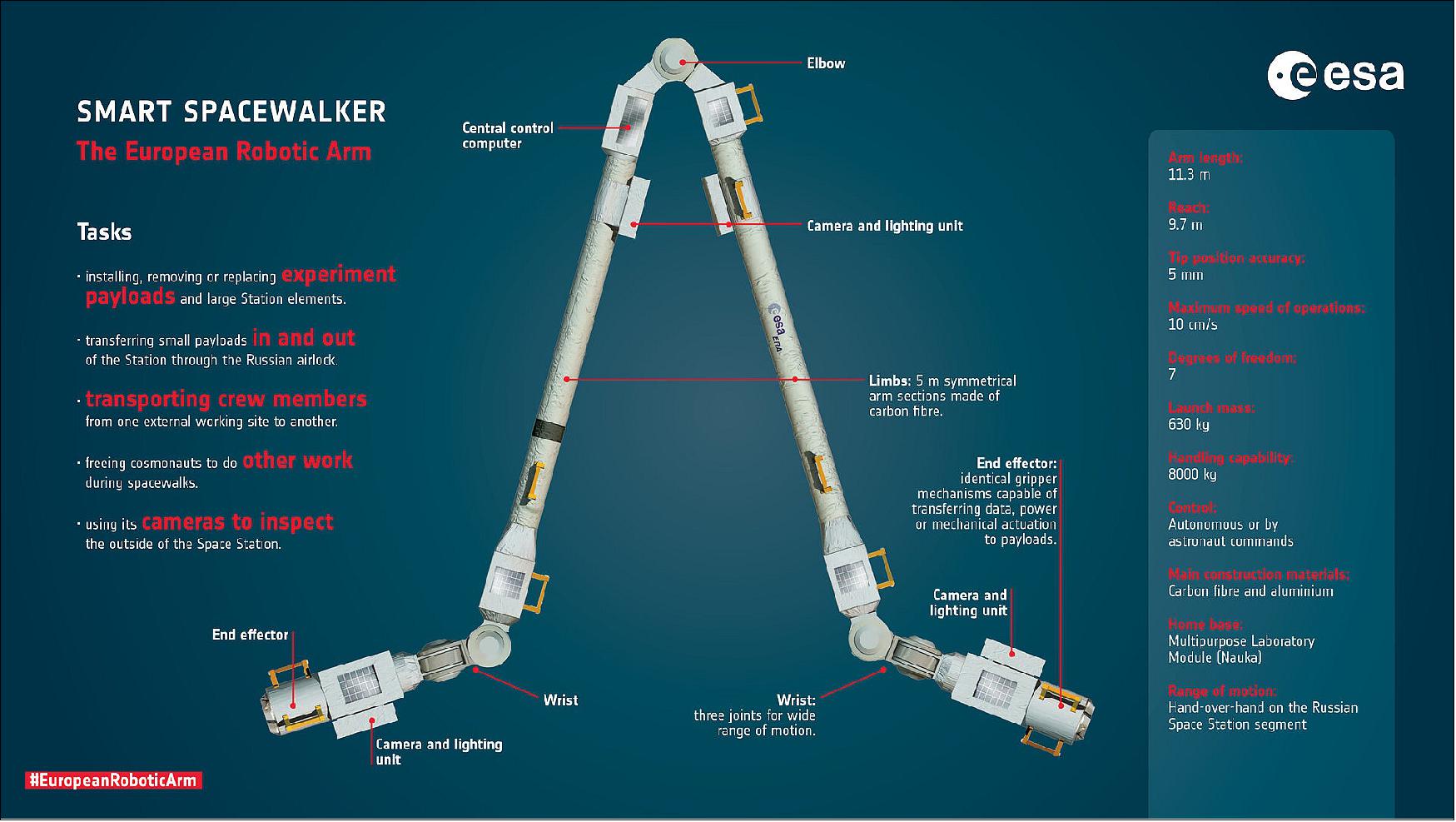
Figure 13: The European Robotic Arm is the first robot that can ‘walk’ around the Russian part of the International Space Station (image credit: ESA)
- ERA has a length of over 11 m, and can anchor itself to the Station in multiple locations, moving backwards and forwards around the Russian segment with a large range of motion. Its home base will be the Multipurpose Laboratory Module, also called ‘Nauka’.
- Astronauts will find in the European Robotic Arm a most valuable ally – it will save them precious time to do other work in space.
- The crew in space can control ERA from both inside and outside the Space Station, a feature that no other robotic arm has offered before.
- 100% made-in-Europe, this intelligent robotic arm consists of two end effectors, two wrists, two limbs and one elbow joint together with electronics and cameras. Both ends act as either a 'hand' for the robot.
- Europe’s robotic arm brings new ways of operating automated machines to the orbital complex. It will be able to perform many tasks automatically or semi-automatically, can be directed either from inside or outside the Station, and it can be controlled directly or programmed in advance.
- At ESA’s technical heart, ESTEC in the Netherlands, engineers will be following the spacewalk closely. A European team will be monitoring Samantha’s work on the robotic arm from its mission control.
• July 19, 2022: A variety of new space science is under way aboard the International Space Station following Saturday’s delivery aboard the SpaceX Dragon resupply ship. The Expedition 67 crew members are helping researchers on the ground take advantage of weightlessness to reveal new phenomena potentially benefitting humans on Earth and in space. 10)
- NASA Flight Engineer Bob Hines kicked off a new experiment today that looks at how the human immune system adapts to microgravity. Hines set up the Life Science Glovebox inside the Kibo laboratory module then serviced tissue samples for the Immunosenescence investigation. Results may inform treatments for accelerated aging processes observed in space as well as normal aging conditions on Earth.
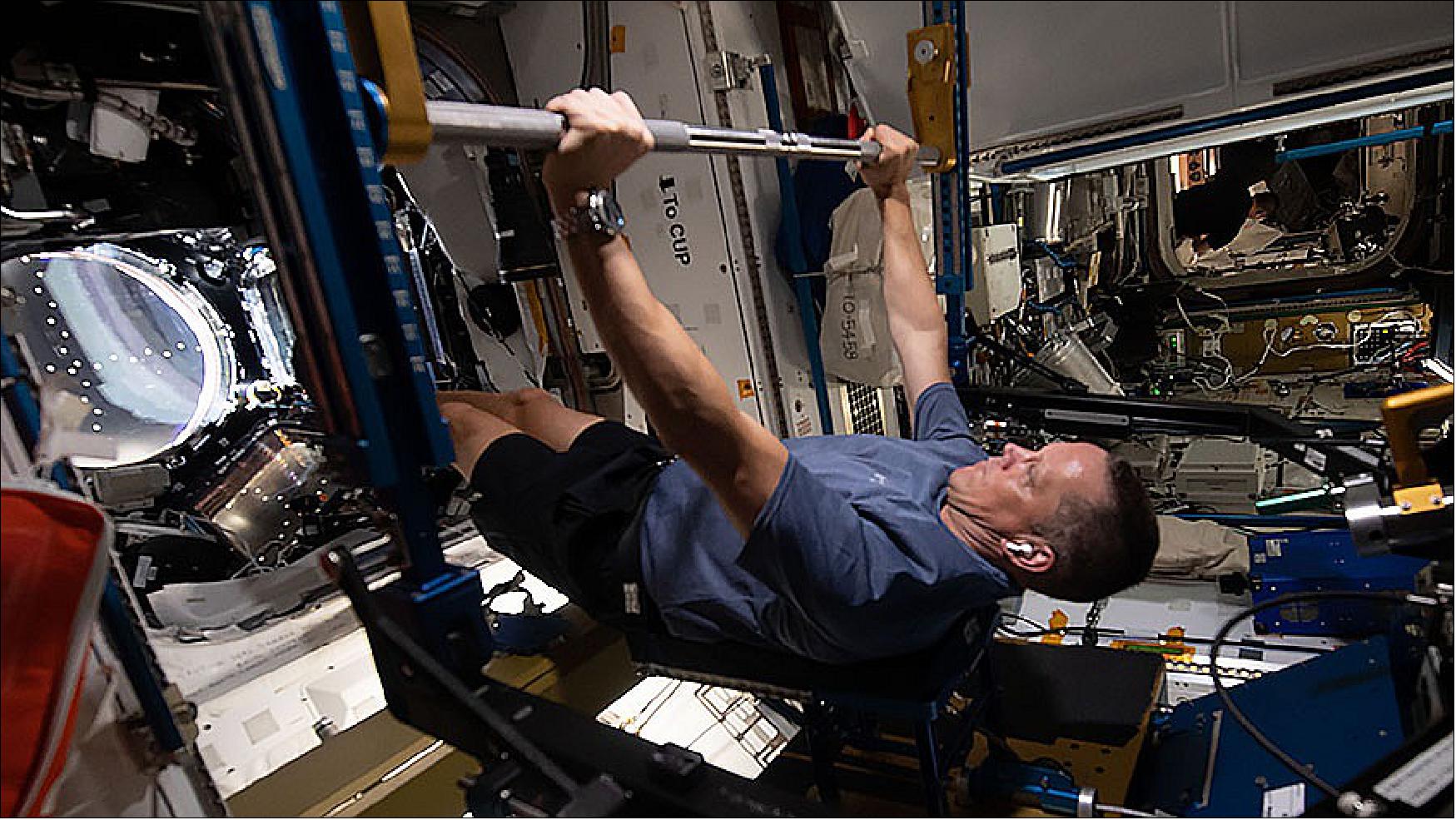
Figure 14: Astronaut Bob Hines works out on the space station’s Advanced Resistive Exercise Device (ARED) that mimics lifting free weights on Earth (image credit: NASA TV)
- NASA Flight Engineer Kjell Lindgren spent his day working on a pair of different experiments and configuring science hardware. He first started exploring techniques to manufacture optical fibers in space. Afterward, Lindgren began demonstrating ways to improve water recycling farther away from Earth. The two-time station visitor also disconnected components on a thermal spacesuit experiment and transferred samples stowed in Dragon to science freezers in Kibo and the U.S. Destiny laboratory module.
- Astronauts Jessica Watkins of NASA and Samantha Cristoforetti of ESA (European Space Agency) studied how motion and distance perception is altered in microgravity. The duo worked in the Columbus laboratory module wearing virtual reality goggles and a neck brace while clicking on a trackball in response to visual and aural stimuli. Insights may lead to improved controls for space vehicles and more effective visual cues on Earth.
• July 18, 2022: New science experiments continue to be unpacked from inside the newly-arrived SpaceX Dragon resupply ship. The seven Expedition 67 crew members also ensured the International Space Station continues orbiting Earth in tip-top shape. 11)
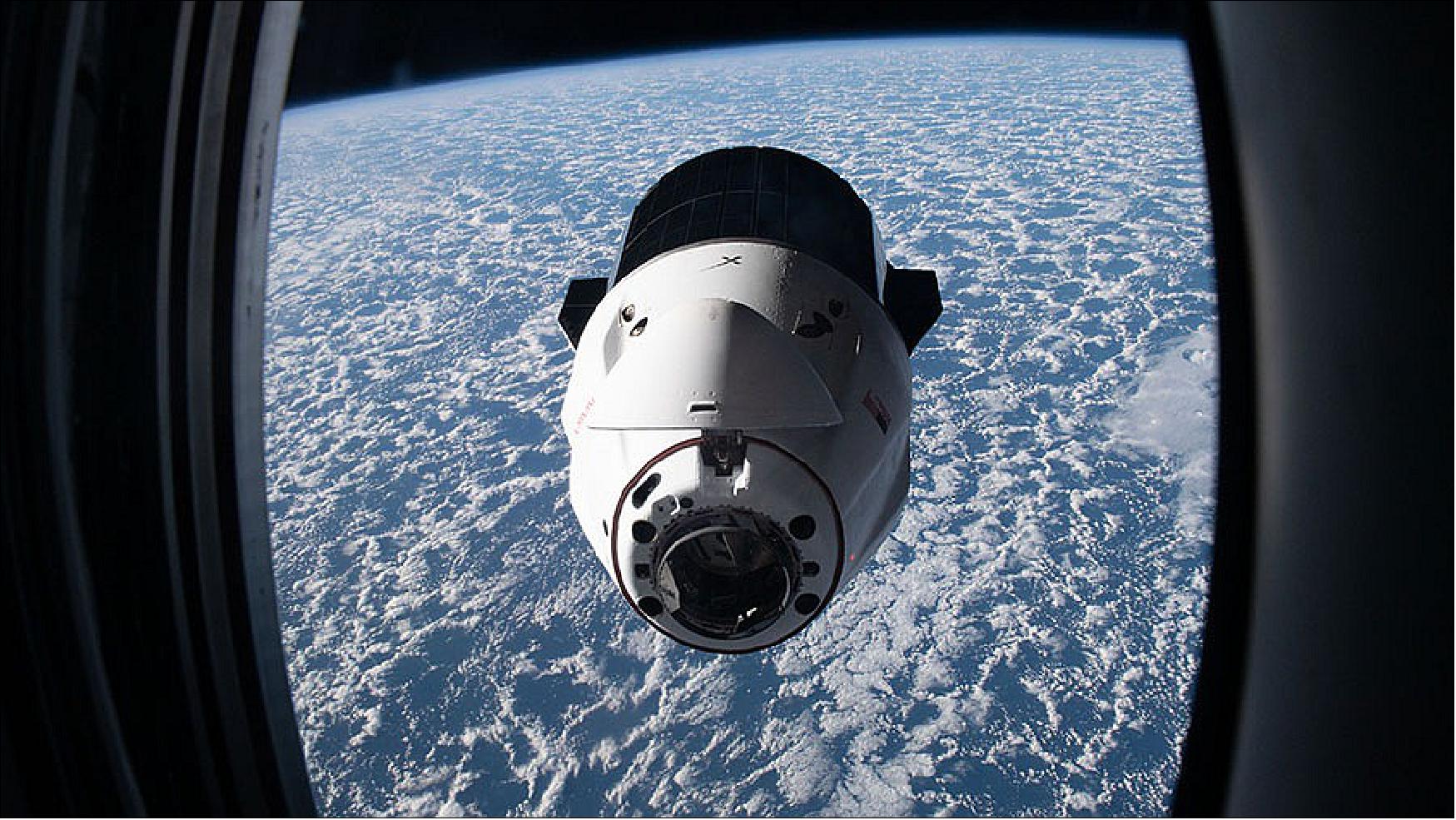
Figure 15: The SpaceX Dragon resupply ship carrying over 5,800 pounds of cargo approaches the space station above the south Atlantic Ocean on July 16, 2022 (image credit: NASA TV)
- NASA Flight Engineers Jessica Watkins and Bob Hines spent Monday unloading some of the more than 5,800 pounds of science experiments and crew supplies delivered on Saturday inside the Dragon cargo craft. The duo transferred time-critical research samples into the orbital lab to begin exploring a variety of space phenomena to benefit humans on and off the Earth. Some of the new experiment include a human immune system study, a protein production investigation, and a cancer treatment experiment.
- NASA Flight Engineer Kjell Lindgren assisted Watkins and Hines today moving science freezers inside Dragon to access cargo pallets. Lindgren also tended to radishes and mizuna greens growing using hydroponic and aeroponic methods for the XROOTS space botany study. ESA (European Space Agency) astronaut Samantha Cristoforetti tested computer connections inside the European Physiology Module that supports neuroscientific, cardiovascular, and physiological studies inside the Columbus laboratory module.
- The station’s three cosmonauts focused mainly on life support maintenance duties. Commander Oleg Artemyev and Flight Engineer Denis Matveev serviced Russian ventilation systems replacing vents and filters. Flight Engineer Sergey Korsakov worked on orbital plumbing duties inside the Nauka multipurpose laboratory module.
• July 16, 2022: While the International Space Station was traveling more than 267 miles (430 km) over the South Atlantic Ocean, the SpaceX Dragon cargo spacecraft autonomously docked to the forward-facing port of the station’s Harmony module at 11:21 a.m. EDT (15:21 UTC) today, with NASA astronauts Bob Hines and Jessica Watkins monitoring operations from the station. 12)
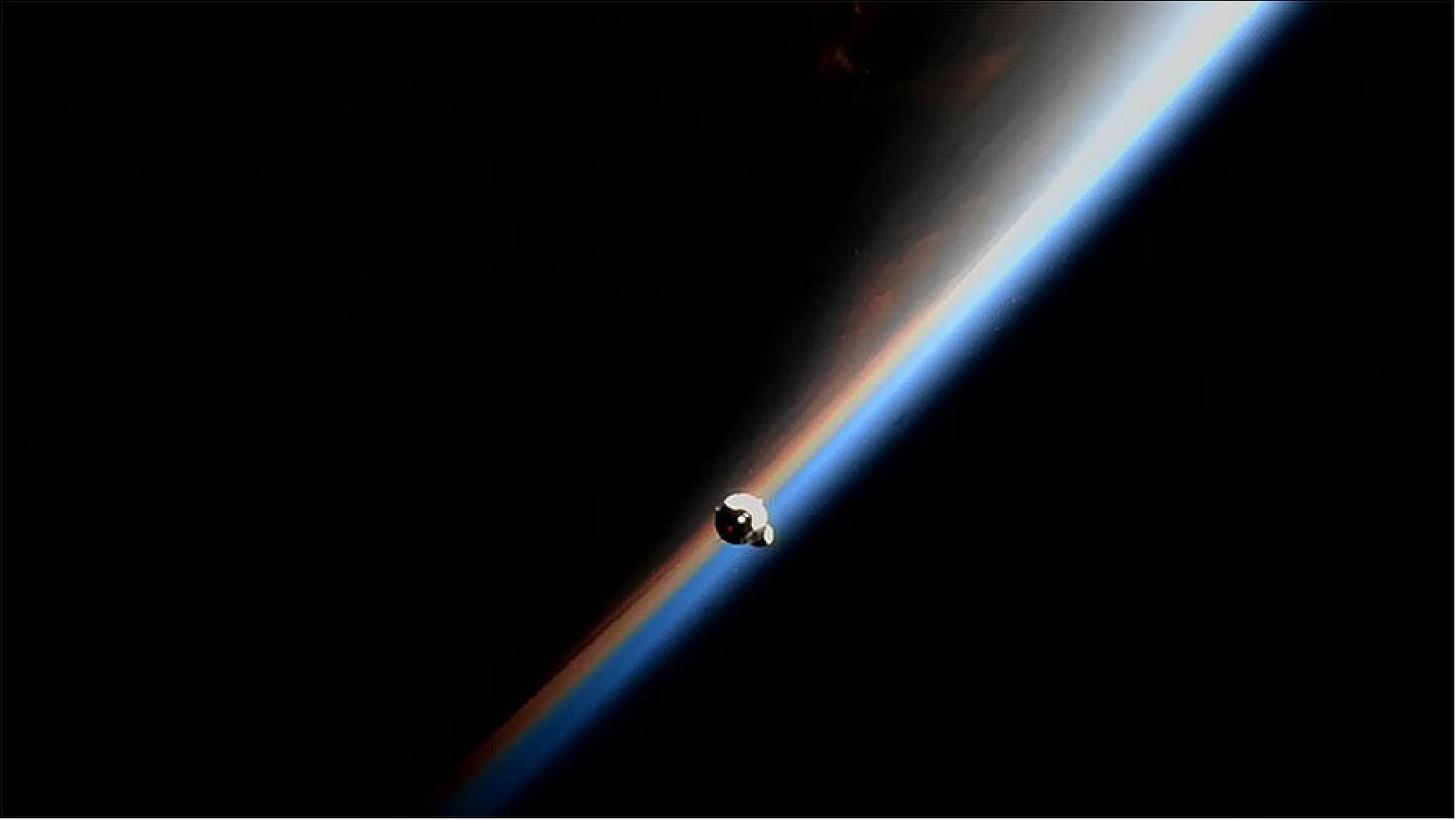
Figure 16: The SpaceX Dragon resupply ship approaches the space station during an orbital sunrise above the Pacific Ocean (image credit: NASA TV)
- The Dragon launched on SpaceX’s 25th contracted commercial resupply mission for NASA at 8:44 p.m., Thursday, July 14 (00:44 UTC on 15 July), from Launch Complex 39A at the agency’s Kennedy Space Center in Florida. After Dragon spends about one month attached to the space station, the spacecraft will return to Earth with cargo and research.
References
1) Andrew Wang / Jane J. Lee, Esprit Smith, ”NASA’s New Mineral Dust Detector Readies for Launch,” NASA Feature, 13 July 2022, URL: https://www.nasa.gov/feature/jpl/nasa-s-new-mineral-dust-detector-readies-for-launch
2) Jeff Foust, ”SpaceX launches cargo Dragon mission to ISS,” SpaceNews, 14 July 2022, URL: https://spacenews.com/spacex-launches-cargo-dragon-mission-to-iss/
3) ”CRS-25 Mission,” SpaceX, 14 July 2022, URL: https://www.spacex.com/launches/crs-25/
4) ”NASA, SpaceX Launch Climate Science Research, More to Space Station,” NASA/JPL, 14 July 2022, URL: https://www.jpl.nasa.gov/news/nasa-spacex-launch-climate-science-research-more-to-space-station?utm_source=iContact&utm_medium=email&utm_campaign=nasajpl&utm_content=daily20220714-1
5) Melissa Gaskill, ”Soil, Satellites, and Climate Modeling Among Investigations Riding SpaceX CRS-25 Dragon to International Space Station,” NASA, 24 May 2022, URL: https://www.nasa.gov/mission_pages/station/research/news/spacex-25-research-highlights
6) Viorel Bostan, Nicolae Secrieru, Valentin Ilco, Vladimir Melnic, Alexei Martiniuc, Vladimir Varzaru, ”TUMnanoSAT, 1U KiboCube Nanosatellite Developed at the Technical University of Moldova,”Proceedings of the 35th Annual AIAA/USU Virtual Conference on Small Satellites, August 7-12, 2021, Logan, UT, USA, Paper: SSC21-P2-38, URL: https://digitalcommons.usu.edu/smallsat/2021/all2021/24/, and https://digitalcommons.usu.edu/cgi/viewcontent.cgi?article=4898&context=smallsat
7) ”A spacewalk full of firsts,” ESA Science & Exploration, 27 July 2022, URL: https://www.esa.int/ESA_Multimedia/Images/2022/07/A_spacewalk_full_of_firsts
8) Mark Garcia, ”Russian, European Spacewalkers Wrap Up Robotic Arm Excursion,” NASA Space Station, 21 July 2022, URL: https://blogs.nasa.gov/spacestation/2022/07/21/russian-european-spacewalkers-wrap-up-robotic-arm-excursion/
9) ”First spacewalk for Samantha Cristoforetti,” ESA Science & Exploration, 20 July 2022, URL: https://www.esa.int/Science_Exploration/Human_and_Robotic_Exploration/First_spacewalk_for_Samantha_Cristoforetti
10) Mark Garcia, ”Astronauts Pursue New Research to Benefit Humans on Earth, Space,” NASA Space Station, 19 July 2022, URL: https://blogs.nasa.gov/spacestation/2022/07/19/astronauts-pursue-new-research-to-benefit-humans-on-earth-space/
11) Mark Garcia, ”Crew Unpacking New Science Experiments from Dragon,” NASA Space Station, 18 July 2022, URL: https://blogs.nasa.gov/spacestation/2022/07/18/crew-unpacking-new-science-experiments-from-dragon/
12) Mark Garcia, ”Dragon Docks Delivering Science Benefitting Humans,” NASA Space Station, 16 July 2022, URL: https://blogs.nasa.gov/spacestation/2022/07/16/dragon-docks-delivering-science-benefitting-humans/
The information compiled and edited in this article was provided by Herbert J. Kramer from his documentation of: ”Observation of the Earth and Its Environment: Survey of Missions and Sensors” (Springer Verlag) as well as many other sources after the publication of the 4th edition in 2002. - Comments and corrections to this article are always welcome for further updates (eoportal@symbios.space).